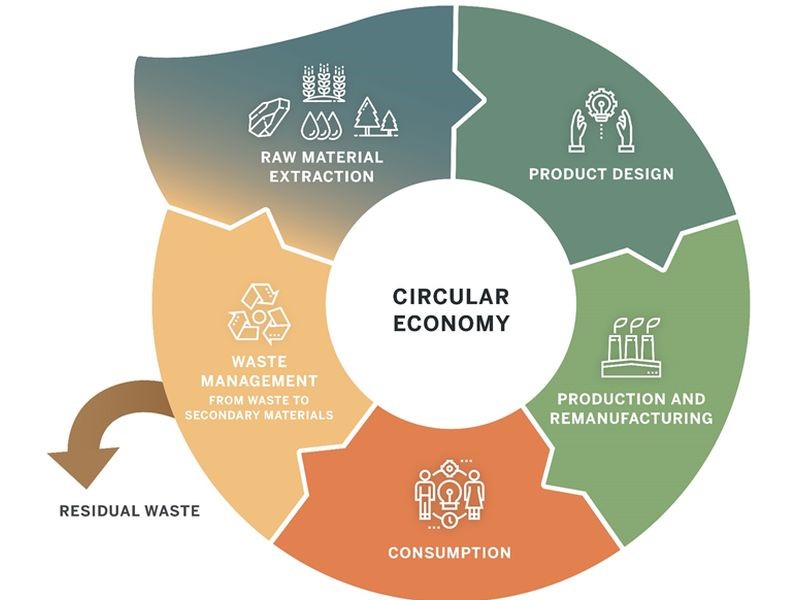The European Commission released its new Circular Economy Action Plan (CEAP) in support of the European Green Deal on 11 March 2020.
It fits in a preeminent list of EU strategy documents with a strong impact on standardization, such as the new Biodiversity Strategy, the Farm to Fork Strategy, the Industrial Strategy, the Chemicals Strategy for Sustainability and the Sustainable Products Initiative. “To achieve climate-neutrality by 2050, to preserve our natural environment, and to strengthen our economic competitiveness, requires a fully circular economy,” said Frans Timmermans, the Commission’s vice-president in charge of overseeing the European Green Deal.
Europe’s economy is still mostly linear, Timmermans pointed out, with only 12% of materials recycled and brought back into the economy. “Many products break down too easily, cannot be reused, repaired or recycled, or are made for single use only,” the Dutchman pointed out, saying that the Commission’s new circular economy plan aims to “transform the way products are made and empower consumers to make sustainable choices”.
Building on the work already undertaken in the transition towards a more circular European economy, the Action Plan sets out objectives in product design, production and consumption. “We only have one Planet Earth and yet, by 2050 we will be consuming as if we had three,” added Virginijus Sinkevičius, the EU’s environment Commissioner. “The new plan will make circularity the mainstream in our lives and speed up the green transition of our economy,” he promised. It focuses on the sectors that use most resources and where the potential for circularity is high, such as electronics and ICT; batteries and vehicles; packaging; plastics; textiles; construction and buildings; food; water and nutrients.
This new Action Plan for the Circular Economy will have impacts on most – if not all – businesses in Europe. The need for constant, systematic monitoring of upcoming legislation is now higher than it has ever been for companies to best undertake this transition without affecting their profitability.
In this context, the Circular Economy Topic Group (CE-TG) of SABE was set up to provide a faster and more coordinated response to the horizontal and cross sectorial standardization needs related to the European Circular Economy-related initiatives.
The SABE CE-TG focuses on identifying and discussing strategic standardization issues and needs related to Circular Economy within CEN and CENELEC and the coordination with other standard organisations. It supports SABE in advising the CEN and CENELEC Technical Boards on standardization priorities for instance in support of the implementation of the Circular Economy Action Plan.
The sectors affected by the CEAP
Here below it is possible to find a complete list of the sectors affected by the Circular Economy Action Plan. In contrast to the former Action Plan, which was largely based on sector-specific incentives with very little regulation, the CEAP is regulatory-based with a number of major new regulations in the pipeline along with amendments of existing directives to include stricter targets and actions.
- NEW PRODUCT TYPES TO THE ECODESIGN DIRECTIVE: The CEAP builds upon the “Sustainable Products Initiative” which intends to revise the Ecodesign Directive, extending its product scope (energy-related products currently), by including new types of products and to propose additional legislative measures aiming to make products placed on the EU market more sustainable. Consumers, the environment and the climate will benefit from products that are more durable, reusable, repairable, recyclable, and energy-efficient.
- ELECTRICAL AND ELECTRONICS: A ‘Circular Electronics Initiative’ to promote longer product lifetimes through reusability and reparability as well as upgradeability of components and software to avoid premature obsolescence. This will include a “right to repair” for products like smartphones and computers, by 2021.
- BATTERIES: New rules to improve the collection and recycling rates of all batteries and ensure the recovery of valuable materials, sustainability requirements for batteries, the level of recycled content in new batteries.
- PLASTICS: In the plastics sector, the CEAP intends to expand on the ban of single-use packaging in the EU by driving design for reuse and recyclability of packaging and address the over-complexity of packaging to decrease the incidence of overpackaging. It also intends to restrict the intentional addition of microplastics in some products, develop a standard label that will consider the sustainability of the plastic products used and encourage the use of biodegradable and compostable plastic solutions.
- TEXTILES: Recognizing the widespread environmental impact of the textiles industry, the Commission includes a Comprehensive EU Strategy for Textiles in the document, including an series of consumer and producer-based measures, reflecting the complexity of the EU textile value chain, with the goal of increasing the uptake of sustainable textiles and easy access to re-use and repair.
- CONSTRUCTION: The Construction industry is addressed in the CEAP, mainly with a planned revision of the Construction Product Regulation, setting minimum targets for recycled content requirements for certain products. Furthermore, a revision of material recovery targets set in EU legislation for construction and demolition waste and its material-specific fractions is also planned. A “strategy for a sustainable built environment” to promote circularity principles throughout the whole lifecycle of buildings. This will include green criteria for public procurement in construction.
- FOOD: The CEAP also focuses on food. The actions featured in the document are mainly addressed in other strategy documents such as the Green Deal and the Farm to Fork Strategy. One of the actions planned for the industry is the development of an Integrated Nutrient Management Plan to better manage the inputs in the European agricultural sector and address the regulatory gaps in the use of recovered nutrients.
- OTHER CROSSCUTTING MEASURES: Finally, some crosscutting measures that concern all sectors will also be implemented. The aim of these measures is to integrate sustainability and circularity throughout the whole European economy. In addition to incentives for business-led initiatives to develop environmental accounting and integrate sustainability into business strategies, regulatory measures such as the review of the non-financial disclosure directive are also planned along with additional measures aimed at tightening the requirements for public funding, adding circularity and sustainability criteria for the obtaining of funds.
More information on how standardization supports the ambitions towards a fully circular economy can be found on CEN and CENELEC’s dedicated brochure 'Standardization in a Circular Economy – Closing the Loop'.
For more information, please contact the CEN-CLC SABE CE-TG Secretariat or Andrea NAM.




